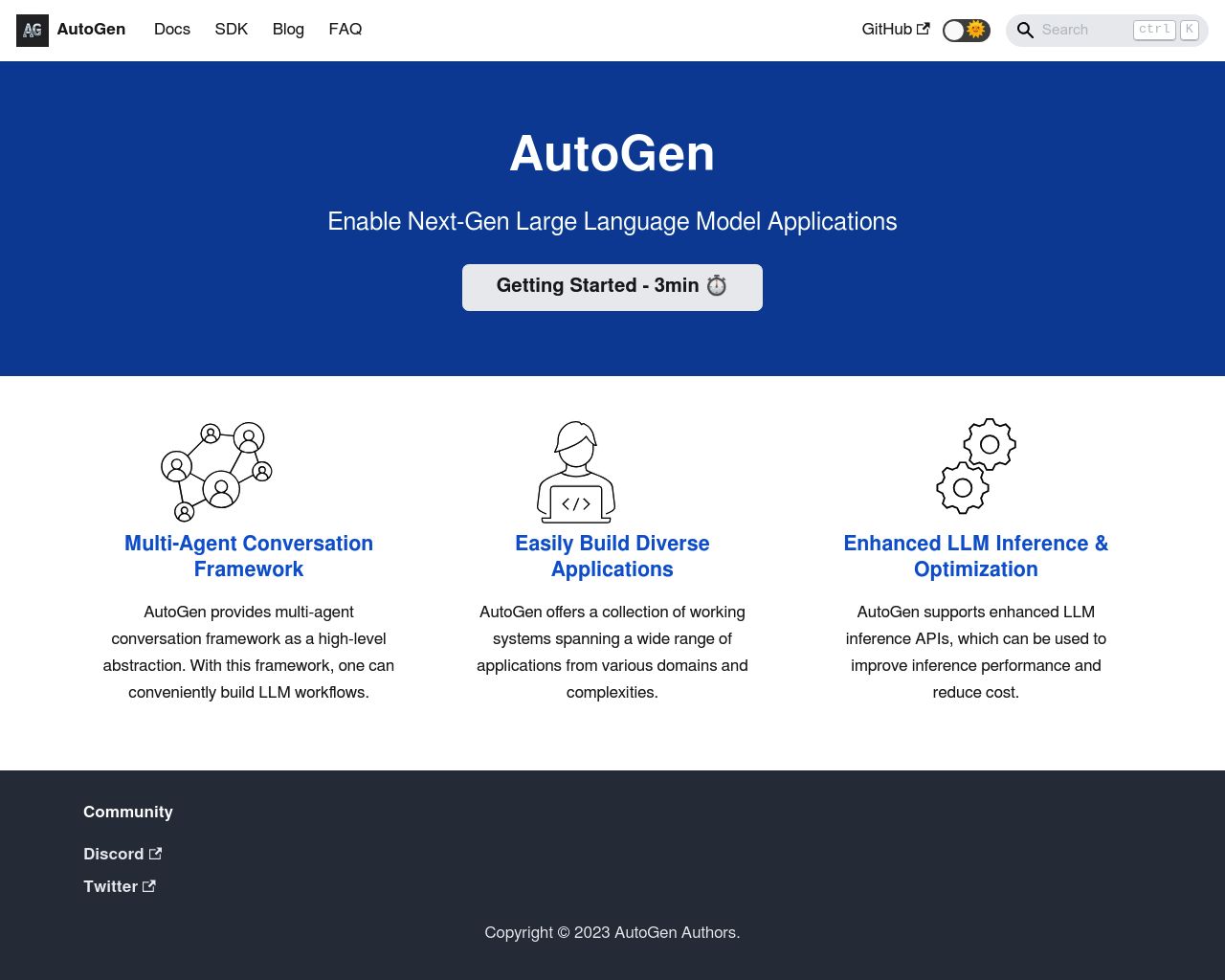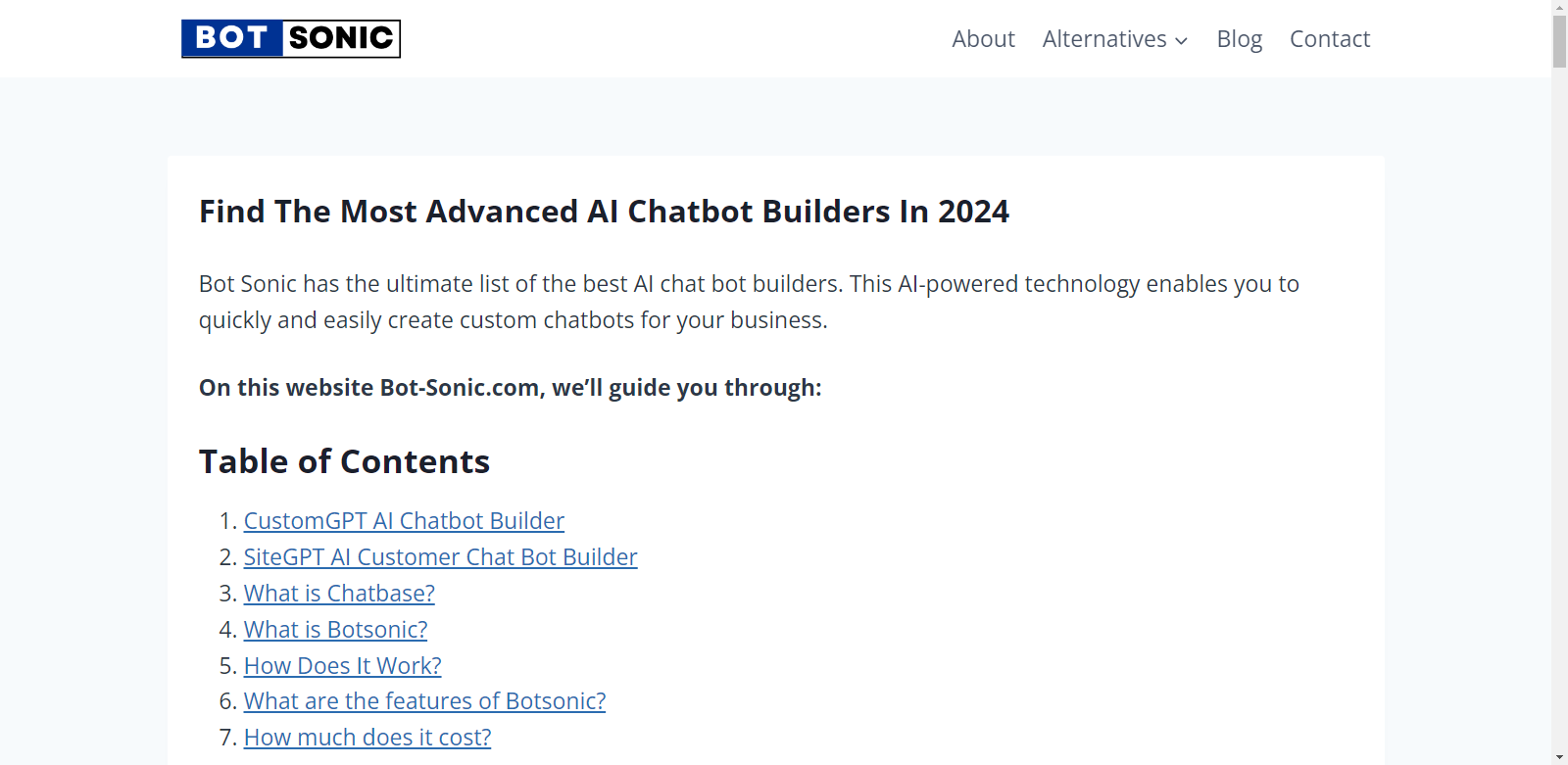AutoGen vs. Botsonic/Writesonic: A Comprehensive Comparison
AI agents revolutionize how businesses and developers approach complex tasks, automate processes, and enhance customer interactions. This comparison delves into AutoGen, Botsonic/Writesonic, and SmythOS, three platforms at the forefront of AI agent technology. We explore their unique approaches to agent creation, deployment, and management, highlighting key features, strengths, and limitations. Whether you’re a developer seeking advanced multi-agent capabilities, a business looking for quick chatbot solutions, or an organization requiring a versatile AI platform, this analysis provides insights to guide your choice in the evolving landscape of AI-powered tools.
AutoGen Overview
AutoGen empowers developers to create sophisticated AI applications through multi-agent conversations. This open-source framework enables the creation of customizable agents that interact with each other, Large Language Models (LLMs), tools, and humans to tackle complex tasks.


AutoGen’s core strength lies in its ability to facilitate autonomous multi-agent collaborations. These agents can work together to solve problems, generate code, and engage in continuous learning. The framework maximizes LLM performance through advanced inference capabilities, including tuning, caching, and error handling.
AutoGen’s core strength lies in its ability to facilitate autonomous multi-agent collaborations… to solve problems, generate code, and engage in continuous learning.
Developers can tailor agents to specific needs, integrating LLMs, human inputs, and various tools. AutoGen supports both fully autonomous operations and human-in-the-loop problem-solving, making it adaptable for a wide range of applications. From automated task solving to complex problem-solving in group chats, AutoGen demonstrates versatility across diverse use cases.
The platform includes essential debugging and logging tools, crucial for optimizing LLM-based systems. AutoGen also features EcoOptiGen, a cost-effective technique for tuning large language models, underlining its focus on enhancing LLM efficiency and effectiveness.
While AutoGen offers powerful capabilities for AI development, it requires coding knowledge to set up agents and workflows. This may pose a challenge for users seeking a no-code solution. Additionally, the framework’s emphasis on code-based configuration might necessitate a steeper learning curve for those new to AI development.
Botsonic/Writesonic Overview
Botsonic/Writesonic offers a no-code AI chatbot builder designed for businesses seeking to enhance customer interactions through intelligent automation. This tool leverages advanced AI models like GPT-4 to create customizable chatbots without requiring coding expertise.


Botsonic/Writesonic excels in rapid deployment, allowing businesses to integrate AI-powered chatbots into their websites within minutes using a simple embeddable code. The platform’s AI-driven intelligence delivers personalized conversational experiences, adapting to various industries and use cases. Extensive customization options enable users to align chatbot appearances and behaviors with their brand identity.
Botsonic/Writesonic excels in rapid deployment, allowing businesses to integrate AI-powered chatbots into their websites within minutes using a simple embeddable code.
Multilingual support for over ten languages expands the tool’s global reach, ensuring contextually accurate responses across diverse markets. Botsonic/Writesonic integrates seamlessly with popular platforms like Salesforce, Google Docs, WhatsApp, and Telegram, enhancing its versatility in different business ecosystems.
The platform’s user-friendly training feature allows businesses to upload various file formats and website links, effectively teaching chatbots to provide relevant, industry-specific responses. This capability significantly reduces support volume, freeing human agents to focus on complex interactions that require a personal touch.
The platform’s user-friendly training feature allows businesses to upload various file formats and website links, effectively teaching chatbots to provide relevant, industry-specific responses.
While Botsonic/Writesonic offers impressive features for creating AI chatbots, it may have limitations in more advanced AI agent functionalities. The platform primarily focuses on conversational AI and customer support automation, which may not fully meet the needs of users seeking more complex AI agent capabilities or extensive customization options for specialized tasks beyond chatbot interactions.
Feature Comparison
AutoGen and Botsonic/Writesonic offer distinct approaches to AI agent development, with notable feature gaps in core components and security. AutoGen provides a flexible framework for creating sophisticated multi-agent systems, emphasizing code-based configuration and advanced AI capabilities. It excels in facilitating autonomous agent collaborations and enhancing Large Language Model performance through advanced inference techniques.
Botsonic/Writesonic, conversely, focuses on no-code AI chatbot creation for business customer interactions. Its strength lies in rapid deployment and user-friendly customization, allowing quick integration of AI-powered chatbots into websites. While Botsonic/Writesonic offers impressive chatbot capabilities, it lacks the depth of AI agent functionalities found in AutoGen, such as multi-agent collaboration and extensive problem-solving capabilities.
In terms of security, AutoGen supports OAuth authentication and provides logging features, but lacks specific mentions of data encryption or IP control. Botsonic/Writesonic’s security features are not prominently highlighted, potentially leaving gaps in advanced security measures. SmythOS addresses these limitations by offering robust security features including data encryption, OAuth, and IP control, alongside a comprehensive set of AI agent development tools that balance ease of use with advanced capabilities.
Feature Comparison Table
| AutoGen | Botsonic/Writesonic | SmythOS | |
|---|---|---|---|
| CORE FEATURES | |||
| Visual Builder | ❌ | ❌ | ✅ |
| No-Code Options | ❌ | ✅ | ✅ |
| Debug Tools | ✅ | ❌ | ✅ |
| Multimodal | ✅ | ❌ | ✅ |
| Multi-Agent Collaboration | ✅ | ❌ | ✅ |
| Work as Team | ✅ | ❌ | ✅ |
| Bulk Work | ✅ | ❌ | ✅ |
| Agent Work Scheduler | ❌ | ❌ | ✅ |
| SECURITY | |||
| Constrained Alignment | ❌ | ❌ | ✅ |
| Data Encryption | ✅ | ❌ | ✅ |
| OAuth | ✅ | ❌ | ✅ |
| IP Control | ❌ | ✅ | ✅ |
| COMPONENTS | |||
| Huggingface AIs | ✅ | ❌ | ✅ |
| Zapier APIs | ✅ | ❌ | ✅ |
| Classifiers | ✅ | ❌ | ✅ |
| Data Lakes | ❌ | ❌ | ✅ |
| DEPLOYMENT OPTIONS (EMBODIMENTS) | |||
| Deploy as Webhook | ✅ | ❌ | ✅ |
| Staging Domains | ❌ | ❌ | ✅ |
| Production Domains | ❌ | ✅ | ✅ |
| API Authentication (OAuth + Key) | ✅ | ❌ | ✅ |
| Deploy as Scheduled Agent | ❌ | ❌ | ✅ |
| DATA LAKE SUPPORT | |||
| Hosted Vector Database | ❌ | ❌ | ✅ |
| Sitemap Crawler | ❌ | ✅ | ✅ |
| YouTube Transcript Crawler | ❌ | ✅ | ✅ |
Best Alternative to AutoGen and Botsonic/Writesonic
SmythOS emerges as the superior alternative to AutoGen and Botsonic/Writesonic for AI agent development and deployment. Our platform combines the best of both worlds — the advanced AI capabilities of AutoGen and the user-friendly approach of Botsonic/Writesonic — while offering unique features that set us apart.
SmythOS emerges as the superior alternative to AutoGen and Botsonic/Writesonic for AI agent development and deployment.
We designed SmythOS with versatility and ease of use in mind. Our visual drag-and-drop interface allows users to create sophisticated AI workflows without extensive coding knowledge. This democratizes AI development, making it accessible to both technical experts and business users alike. Unlike AutoGen’s code-heavy approach or Botsonic/Writesonic’s limited chatbot focus, we enable the creation of diverse AI applications, from chatbots to complex multi-agent systems.
Our visual drag-and-drop interface allows users to create sophisticated AI workflows without extensive coding knowledge.
Our platform shines in its comprehensive feature set. We offer autonomous agent capabilities, multi-agent collaboration, and advanced problem-solving tools that surpass both AutoGen and Botsonic/Writesonic. SmythOS supports multimodal interactions, allowing agents to process and generate various data types including text, images, and more. This flexibility ensures our agents can handle a wide array of tasks across different industries and use cases.
Security and scalability are paramount in SmythOS. We provide robust data encryption, OAuth authentication, and IP control features, addressing the security gaps in both AutoGen and Botsonic/Writesonic. Our platform scales effortlessly from small projects to enterprise-level deployments, with staging and production environments to support seamless development and rollout of AI solutions.
We provide robust data encryption, OAuth authentication, and IP control features, addressing the security gaps in both AutoGen and Botsonic/Writesonic.
With SmythOS, users benefit from a unified ecosystem for AI agent development, deployment, and management. We offer unparalleled integration capabilities, supporting various AI models, APIs, and data sources. This comprehensive approach, combined with our intuitive interface and powerful features, makes SmythOS the ideal choice for organizations seeking to leverage AI technology effectively and efficiently.
Conclusion
AutoGen and Botsonic/Writesonic each offer unique approaches to AI agent development, catering to different user needs. AutoGen excels in creating sophisticated multi-agent systems for developers, while Botsonic/Writesonic provides a user-friendly platform for businesses to quickly deploy AI chatbots. However, both platforms have limitations that SmythOS effectively addresses.
SmythOS stands out by offering a comprehensive solution that combines the best of both worlds. Our platform provides the depth and flexibility of AutoGen’s multi-agent capabilities with the ease of use and rapid deployment of Botsonic/Writesonic. SmythOS’s drag-and-drop interface, extensive integration ecosystem, and versatile deployment options make it accessible to both technical and non-technical users.
Unlike AutoGen, which requires coding knowledge, or Botsonic/Writesonic, which focuses primarily on chatbots, SmythOS enables users to create and deploy a wide range of AI agents for various applications. Our platform supports multi-agent orchestration, allowing teams of AI agents to collaborate on complex tasks, significantly enhancing efficiency and scalability.
We invite you to explore our diverse range of AI-powered agent templates and experience the power of SmythOS firsthand. Create a free SmythOS account today and join the AI revolution, where you can build and deploy AI agents 99% faster, transforming your workflows and driving innovation across your organization.
Last updated:
Disclaimer: The information presented in this article is for general informational purposes only and is provided as is. While we strive to keep the content up-to-date and accurate, we make no representations or warranties of any kind, express or implied, about the completeness, accuracy, reliability, suitability, or availability of the information contained in this article.
Any reliance you place on such information is strictly at your own risk. We reserve the right to make additions, deletions, or modifications to the contents of this article at any time without prior notice.
In no event will we be liable for any loss or damage including without limitation, indirect or consequential loss or damage, or any loss or damage whatsoever arising from loss of data, profits, or any other loss not specified herein arising out of, or in connection with, the use of this article.
Despite our best efforts, this article may contain oversights, errors, or omissions. If you notice any inaccuracies or have concerns about the content, please report them through our content feedback form. Your input helps us maintain the quality and reliability of our information.
